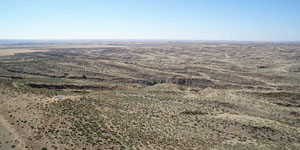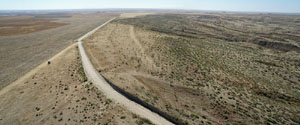
| Arikaree Breaks
Kansas
J.S. and S.W. Aber |
Introduction
Arikaree Breaks, in the far northwestern corner of Kansas, is a part of the High Plains that has been deeply eroded into a badlands type of terrain. Altitude is relatively high at just over 3600 feet (>1100 m) elevation, which makes for thinner air that affects kite flying see high-altitude KAP. This site is, in fact, the highest elevation where we've conducted KAP in Kansas.
Arikaree Breaks is underlain by thick wind-blown sediment, known as loess, that was deposited during the Ice Age. This material consists mostly of silt-sized dust, which is 30 to 65 feet thick here (Muhs 2010). The dust was blown out of the Sand Hills in Nebraska and northeastern Colorado by northwesterly glacial wind.
Loess is highly erodible by wind and water, which have sculpted an intricate network of deep gullies, ravines, and canyons. Total elevation relief in the area is some 400 feet from the edge of the High Plains upland down into the North Fork Republican River valley to the north.

| Panoramic view looking southward along Cheyenne County Road 10. Flat upland of the High Plains to left and deeply eroded terrain of Arikaree Breaks to right. Kite flyers on left side. Assembled from two overlapping photos.
| |
We arrived in early autumn on a day with southeast wind gusting at 15-25 mph. Dust was blowing off the dirt roads and fallow fields as tumbleweeds skipped by, certainly not the most pleasant conditions. We found a small triangle of open-range land at the edge of the High Plains upland next to the eroded breaks area. We flew our small delta kite with a long tube tail and utilized the autoKAP Sony camera rig. We took care to work around clumps of yucca plants at the ground site, as we maneuvered the kite and camera rig.
 KAP overlooking Arikaree Breaks
KAP overlooking Arikaree Breaks

| Cheyenne County Road 10. View southward (left) with kite flyers on the left side, and looking to the northwest (right). The road is deeply cut into loess and meanders down into Sand Canyon.
|  |

| Looking to the north (left) and east (right). The flat plowed field is the uppermost edge of the High Plains with the eroded landscape of Arikaree Breaks in the background.
| 
|
 Ground views of Arikaree Breaks
Ground views of Arikaree Breaks

| Left: exposure of loess. The unconsolidated silty sediment is easily eroded. Scale pole marked in feet. Right: clumps of yucca at the KAP ground site. Leaves have needle-sharp tips that are best to avoid.
|  |
Reference
- Muhs, D.R. 2010. The geologic record of dust deposition. American Association for the Advancement of Science, 2010 Annual Meeting. Access online dust deposition.

 Return to airphoto gallery
or Great Plains airphoto homepage.
Return to airphoto gallery
or Great Plains airphoto homepage.
All text and images © by the authors (2021).


![]() Return to airphoto gallery
or Great Plains airphoto homepage.
Return to airphoto gallery
or Great Plains airphoto homepage.